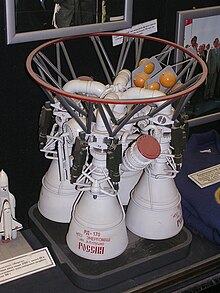RD-171

RD-170 rocket engine model on exhibition in Saint Petersburg's Museum of Space and Missile Technology.
|
|
| Country of origin | Soviet Union/Russian Federation |
|---|---|
| First flight | 1985-04-13 |
| Manufacturer | NPO Energomash |
| Application | Main Engine |
| Associated L/V | Energia |
| Successor | RD-171M |
| Status | Retired |
| Liquid-fuel engine | |
| Propellant | LOX / RG-1 |
| Mixture ratio | 2.63 |
| Cycle | Oxidizer Rich Staged Combustion |
| Configuration | |
| Chamber | 4 |
| Nozzle ratio | 36.87 |
| Performance | |
| Thrust (vac.) | 7,904 kN (1,777,000 lbf) |
| Thrust (SL) | 7,257 kN (1,631,000 lbf) |
| Throttle range | 100% to 40% |
| Thrust-to-weight ratio | 75 |
| Chamber pressure | 24.52 MPa (3,556 psi) |
| Isp (vac.) | 337 s (3.30 km/s) |
| Isp (SL) | 309 s (3.03 km/s) |
| Burn time | 150 seconds |
| Dimensions | |
| Length | 4.0 m (160 in) |
| Diameter | 3.8 m (150 in) |
| Dry weight | 10,750 kg (23,700 lb) |
| Used in | |
| Energia | |
| References | |
| References | |
The RD-170 (РД-170, Ракетный Двигатель-170, Rocket Engine-170) is the world's most powerful liquid-fuel rocket engine, designed and produced in the Soviet Union by NPO Energomash for use with the Energia launch vehicle. The engine burns the Russian equivalent of RP-1 fuel and LOX oxidizer in four combustion chambers, all supplied by one single-shaft, single-turbine turbo pump rated at 170 MW in a staged combustion cycle.
Several Soviet and Russian rocket engines use the approach of clustering small combustion chambers around a single turbine and pump. During the early 1950s, many Soviet engine designers, including Valentin P. Glushko, faced problems of combustion instability while designing bigger thrust chambers. At that time they solved the problem by using a cluster of smaller thrust chambers.
The RD-170 engine featured four combustion chambers and was developed for use on the Energia launch vehicle – both the engine and the launch vehicle were in production only for a short time.
Building on the technology from the Energia launch vehicle the Zenit (rocket family) was developed, which uses a RD-170 variant, the RD-171. While the RD-170 had nozzles which swiveled on both axes, the RD-171 swivels on just one axis. RD-171 was intended to be used on Zenith rocket, and one-axis swiveling allowed to avoid additional aerodynamic forces. Models called the RD-172 and RD-173 were proposed upgrades that would provide additional thrust, but they were never built.
The RD-180 uses only two combustion chambers instead of the four of the RD-170. The RD-180 used on the Atlas V, replaced the three engines used on early Atlas rockets with a single engine and achieved significant payload and performance gains. This engine had also been chosen to be the main propulsion system for the first stage of the now cancelled Russian Rus-M rocket.
...
Wikipedia
